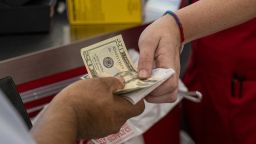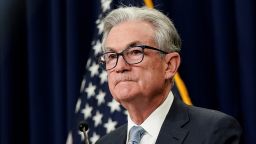At a think tank conference Thursday, Federal Reserve Chairman Jerome Powell reiterated his pledge to stay the course on the central bank’s aggressive inflation-busting policy.
“The Fed has, and accepts, responsibility for price stability,” he said at the Cato Institute’s 40th Annual Monetary Conference. “We need to act right now — forthrightly, strongly.”
As he had at his uncharacteristically brief speech at the Fed’s annual Jackson Hole symposium last month, Powell reaffirmed a commitment to a hawkish policy stance. The Fed chair is trying to temper expectations among consumers and businesses that prices would continue to rise, which could trigger changes in spending, earning and investing habits that could be hard to undo.
“The public had really come to think of higher inflation as the norm” in the 1970s, Chair Powell said, following what he called “failed attempts” to rein in soaring prices — a failure he attributed to the Fed’s unwillingness to keep monetary policy tight enough for long enough.
Powell’s concern that people could habitually come to expect inflation was echoed by Fed vice chair Lael Brainard at a banking policy conference speech in New York on Wednesday. “It is especially important to guard against the risk that households and businesses could start to expect inflation to remain above 2% in the longer run,” she said.
Investors overwhelmingly expect a 75 basis-point hike at the Fed’s upcoming policy-setting meeting later this month as they digest Powell’s remarks, his last comments before the quiet period ahead of the meeting. The tenor suggested to market participants that the Fed won’t stop raising rates even if the Consumer Price Index and Producer Price Index, two key inflation metrics that will be released next week, come in better than expected.
“Their message is that we should expect them to remain in restrictive policy mode even after we start to see inflation data head in the right direction,” said Keith Buchanan, portfolio manager at Globalt Investments. “He went to pretty extensive lengths to dispel assumptions of any pivot coming forward soon.”
The Fed was roundly criticized for underestimating the breadth and duration of the current bout of inflation, and officials want to communicate that they’ve learned their lesson, said Brad Conger, deputy chief investment officer at Hirtle Callaghan. “They’re at pains to say we’re not going to get head-faked by an ephemeral trend,” he said.
While Powell wants to convey that the central bank won’t repeat its earlier mistakes coming out of the pandemic, analysts say he will have a harder task remaining committed to higher rates once it becomes clear that inflation is improving.
“It would be sufficient for them to acknowledge that the near-term rate is trending in the right direction but, definitely, they should not allow that to [influence] their trajectory,” Conger said. “The real dilemma is, how much good data do they need in hand before they pause?”
The challenge will become more acute if the unemployment rate, which is currently near 50-year lows, rises measurably — an outcome another Fed official acknowledged this week was likely. On Wednesday, Cleveland Federal Reserve Bank President Loretta Mester characterized inflation as a key economic challenge on a Market News International webcast.
“Given current rates of inflation, I believe that the Fed has more work to do in order to get inflation under control. This will entail further rate increases to tighten financial conditions,” she said.
It’s an open question how much more joblessness the Fed will be willing to tolerate. “He’s very careful in not pinpointing what level would lead them to change course,” Buchanan said of Powell. “I think it depends on a number of factors [and] there’s a delicate balance he’s having to strike.”
In his remarks on Thursday, Powell didn’t indicate for how long the Fed expected to maintain its current policy trajectory, but some suspect it could be a while, even if officials are willing to accept a higher baseline — say, 3% — rather than their declared 2% inflation target.
“You’re looking at another year of the Fed continuing to raise and or keeping rates where they are,” said Robert Cantwell, portfolio manager at Upholdings.
In the meantime, he added, the economic data crosscurrents that have bedeviled market prognosticators and policymakers alike in recent months are likely to remain a fixture of the economic landscape. “We’re entering a stage here where growth can still be good while unemployment is rising [and] while inflation is falling — which is a very rare setup,” he said.






